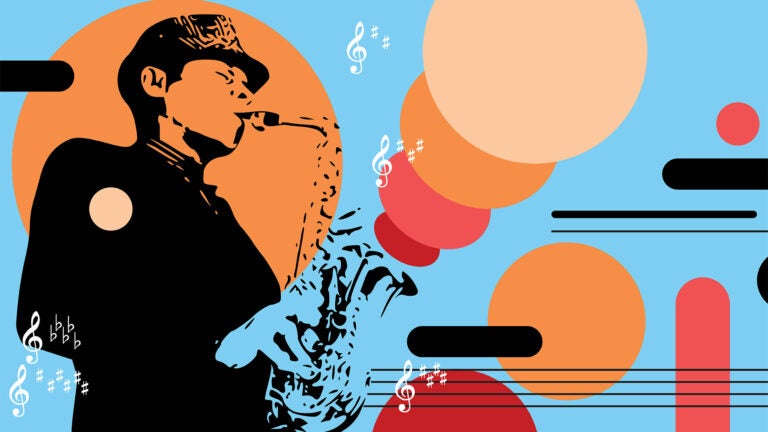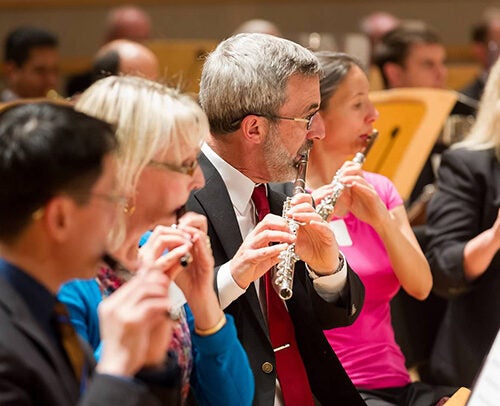
Musical numbers: Math and music nurture a deep and complex relationship
When famed jazz saxophonist, composer and bandleader John Coltrane wanted to illustrate his understanding of music, he turned to mathematics.
Coltrane took the Circle of Fifths, a geometric diagram that sketches out the spatial connections between music notes and expanded it with his own ideas around tonal relationships. His drawing, dubbed Coltrane’s Circle of Tones, has inspired whole essays on “musical geometry.”
Mathematics and music may seem like disparate worlds, but they share a profound, symbiotic relationship that stretches back centuries. This connection isn’t a coincidence. Math is woven into the very essence of the art form, from the way we organize musical scales to the physics that dictates an instrument’s sound. Learning one may even enhance one’s ability to master the other.
The relationship between music and math flows both ways. Prominent Princeton University mathematician Manjul Barghava, a renowned tabla drum player and a poet, said in a Quanta Magazine story, “All kinds of creative thoughts come together when I think about all three.”
This synergy upends the stereotype that mathematicians are exclusively left-brained scholars, disinterested or incapable of soulful expression.
“Mathematicians would actually object to the idea that math isn’t interested in beauty,” says Cymra Haskell, professor (teaching) of mathematics at the USC Dornsife College of Letters, Arts and Sciences, who plays the fiddle. “When I write down a proof of a result in mathematics, it feels like a puzzle coming together. There can be an intense pleasure in that, similar to the pleasure I feel when I listen to a beautiful piece of music or gaze at a beautiful painting or go for a walk in the mountains, on the beach or in a wood.”
Musical numbers

Western music today is based around sets of 12 notes that rise in pitch, called octaves. The tuning of each note isn’t arbitrary; it’s based on math. Each note within an octave has a frequency about 5.95% higher than the previous one. As a result, each note has twice the frequency of the same note an octave lower. Hence, the measured rise as you play through an octave.
Math is also represented, whimsically, in other areas of classical music. Johann Sebastian Bach’s compositions, for instance, are peppered with the numbers 14 and 41. It’s a reference to numerology, which assigns letters of the alphabet individual numbers; that is, A=1, B=2, C=3 and so forth. Adding the numeric values of the letters in Bach’s name — B+A+C+H or 2+1+3+8 — equals 14. And 14 backwards is 41.
Just as musicians benefit from math, mathematicians benefit from music. Ken Alexander, professor of mathematics at USC Dornsife, was a flutist with Orchestra Nova LA (formely known as the Los Angeles Doctors Symphony Orchestra) for 30 years. He says there’s a strong connection between the skills needed to play an instrument and those essential to solving math problems.
“What’s written on a page of music is just a sequence of pitches and how long you hold each pitch. You have to see that, underneath, there are themes, flows and a cadence in the music. There are all kinds of patterns that you have to identify,” he says.
Identifying patterns is also key to mathematical discovery. “In math, a lot of great insights and breakthroughs come about when people see how different parts of mathematics are actually related to each other. Pattern recognition is a very central aspect,” he says.
Research supports Alexander’s assertion. Assal Habibi, an associate professor (research) of psychology, studies how music training affects cognitive outcomes for children through the Brain and Music Lab she heads at USC Dornsife’s Brain and Creativity Institute. She has found that music training enhances executive functions like working memory, which can, in turn, improve mathematical abilities.
“Working memory is about keeping information in your mind and manipulating that information, like remembering a phone number and being able to repeat it backwards,” she explains. Without a robust memory to retain complex information, the pattern recognition Alexander and other mathematicians prize isn’t so feasible.
Strength in numbers
Studying mathematics may seem like a solitary pursuit, but only so much can be done alone, says Alexander. The collaboration between mathematicians to solve a problem mirrors the collaboration between musicians in a band or orchestra. “You work very intensely, mentally, on your own, and then you come together to try to make something out of what you accomplished individually,” he says.
Musical collaborations aren’t unusual for faculty in the USC Dornsife mathematics department. Haskell says she and a colleague recently played the fiddle together. And Alexander often plays with pianist David Kempe, a computer scientist with the USC Viterbi School of Engineering.
Habibi’s research has also demonstrated that music training can enhance social skills, making it an invaluable tool for collaboration.
The children in her study are enrolled in the LA Phil’s Youth Orchestra Los Angeles program. This means they aren’t just learning an instrument on their own. “You really have to pay attention to others and adjust your playing,” she says. Her research found that social skills are another executive ability amplified by music training.
Can adults reap the cognitive benefits of learning music (and perhaps boost their math skills)? Habibi says yes, although the improvements aren’t as pronounced as they are in children.
Her research found that adults with no prior music training, when enrolled in a choir, boosted their speech perception and attention skills, she says.
Another study found that older adults with a limited background in music improved their memory after four months of lessons on the keyboard harmonica.
Perhaps being “math-brained” could have a little something to do with the sound of music.